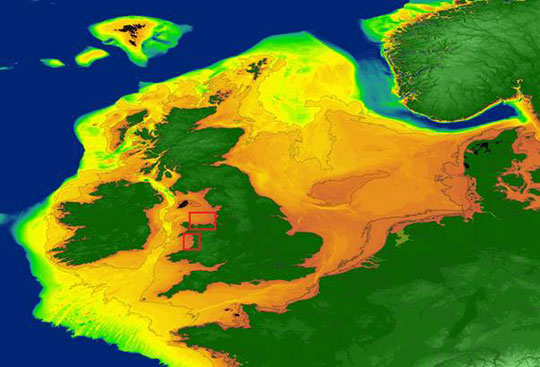The University of Bradford has received an archaeology grant worth £3 million to boost digital research capacity. At a time when grants and financial support for UK universities is under a great deal of pressure, the grant award will help to secure the status of future research projects including the ongoing study of Stone Age communities on the submerged Doggerland in the North Sea.

Approximate maximum extent of marine palaeolandscapes off the Irish and British coasts (survey areas in red). Picture credit: University of Bradford.
Picture credit: University of Bradford
A Substantial Digital Heritage Collection
Bradford University has a substantial digital heritage collection, including human skeletal remains, world heritage landscapes and marine environments. The University, based in West Yorkshire, has become a centre for researchers worldwide. Unfortunately, over time the analysis of and access to this collection has become limited by the technical infrastructure.
An upgrade of the University’s technological capabilities will allow staff to digitise much more of its biological collections and to place these more easily within real-world or reconstructed digital environments, providing a rich virtual environment for other academics, researchers and educators.
Capability for Human Bioarchaeology and Digital Collections
The project entitled Capability for Human Bioarchaeology and Digital Collections will upgrade both the University’s biochemical analysis facilities and its ability to document objects and sites using three-dimensional models. By upgrading its X-ray capabilities to a dedicated CT (computerised tomography) and micro-CT facility the University will be able to capture information in the finest detail with minimal handling of fragile specimens, improving its world-class capability for imaging in human bioarchaeology research.

A virtual reconstruction of the Temple of Bel, Palmyra, Syria. Picture credit: University of Bradford.
Picture credit: University of Bradford
A Pioneer of Digital Data
Scientists at Bradford University have pioneered the development of digitised data online through its Digitised Diseases project, where researchers access images of bone modifications that resulted from a range of diseases.
Digitised Diseases shares data on human skeletal remains through the Biological Anthropology Research Centre (BARC). BARC, a centre for international research in this field, specialises in the analysis of modern and ancient human skeletal remains, a fragile and limited resource.
Bradford University is also a leader in techniques to gather data from archaeological sites, working with past heritage landscapes, the historic environment, and the contemporary environment.
Commenting on the significance of the £3 million funding, Head of the University’s School of Archaeological and Forensic Sciences, Dr Cathy Batt stated:
“By increasing the data available from the human remains collection and combining it with environmental and site data in our collections a rich digital discoverable and searchable research environment will be created. This specifically allows capacity to place our biological collections within real-world or reconstructed digital environments, providing a valuable virtual environment for researchers and educators.”
Everything Dinosaur acknowledges the assistance of a media release in the compilation of this article.
The award-winning Everything Dinosaur website: Dinosaur Models.






Leave A Comment